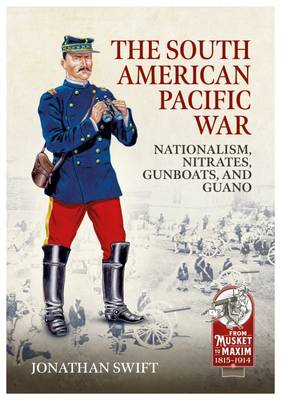
- Retrait gratuit dans votre magasin Club
- 7.000.000 titres dans notre catalogue
- Payer en toute sécurité
- Toujours un magasin près de chez vous
- Retrait gratuit dans votre magasin Club
- 7.000.000 titres dans notre catalogue
- Payer en toute sécurité
- Toujours un magasin près de chez vous
67,45 €
+ 134 points
Description
Peru and Bolivia were decisively beaten by Chile during the War of the Pacific, 1879-1884 and as a direct consequence of this humiliating defeat they suffered extensive territorial losses, including the entire Bolivia coastline. The territories lost contained valuable nitrate and guano deposits, which were exploited by Chile, at a most fortuitous time for the rapidly-degenerating Chilean economy.
Why should countries of similar colonial backgrounds which had co-operated in the defeat of Spanish forces in the early-mid nineteenth century, find themselves at war towards the end of that same century? This book attempts to answer this question, and also explain why the allied forces of Peru and Bolivia were defeated by Chile - even though contemporary commentators favored Peru as the stronger of the three, and consequently Chile was not expected to win in a conflict against Peru, especially when Bolivian forces were also aligned against them. The War of the Pacific was the first modern war to be fought in Latin America; the lessons of the American Civil War (1861-1865) and the Franco - Prussian War (1870-1871) appear to have been largely lost on Peru and Bolivia. It was a war dominated firstly by ironclad battleships, and then by rifled artillery, primitive machine-guns, the first modern infantry rifles, railways, and the telegraph. The battles (on land and at sea) are examined in detail; however, the key to the war was control of the sea, and once this had been lost to Chile, defeat for Peru and Bolivia was all but inevitable.
The first part of this book examines the social structure, political institutions and economies of the three nations. It finishes with an analysis of the external political and diplomatic strategies of each nation, and the growing role played by the European powers (principally Great Britain), and the USA. It shows how the interlinked diplomatic strategies and economic objectives brought conflict ever - closer, and ultimately made it all but inevitable.
Next the military capabilities of the three nations involved is examined: a comparison of the armed forces involved in the conflict, and the weaponry with which each side was equipped. This comparative analysis begins with an examination of the naval forces available to Peru and Chile - Bolivia had no navy, even when she still had a coastline.
The last two parts of the book chart the progress of the war through two basic phases: (1) the Chilean occupation of the Bolivian littoral and town of Antofagasta and the subsequent naval campaigns, and (2) the Chilean land invasion of Peru, and then the progressive land campaigns that resulted in the capture of the capital, Lima. Whilst the war did not officially finish with the Chilean capture of Lima in 1881, this is the point at which the book concludes. From this point until the signing of the final peace treaty, the Chilean occupation forces were plagued by a very successful guerrilla campaign led by Colonel Andrés Cáceres, the most successful Peruvian field commander during the war.
Why should countries of similar colonial backgrounds which had co-operated in the defeat of Spanish forces in the early-mid nineteenth century, find themselves at war towards the end of that same century? This book attempts to answer this question, and also explain why the allied forces of Peru and Bolivia were defeated by Chile - even though contemporary commentators favored Peru as the stronger of the three, and consequently Chile was not expected to win in a conflict against Peru, especially when Bolivian forces were also aligned against them. The War of the Pacific was the first modern war to be fought in Latin America; the lessons of the American Civil War (1861-1865) and the Franco - Prussian War (1870-1871) appear to have been largely lost on Peru and Bolivia. It was a war dominated firstly by ironclad battleships, and then by rifled artillery, primitive machine-guns, the first modern infantry rifles, railways, and the telegraph. The battles (on land and at sea) are examined in detail; however, the key to the war was control of the sea, and once this had been lost to Chile, defeat for Peru and Bolivia was all but inevitable.
The first part of this book examines the social structure, political institutions and economies of the three nations. It finishes with an analysis of the external political and diplomatic strategies of each nation, and the growing role played by the European powers (principally Great Britain), and the USA. It shows how the interlinked diplomatic strategies and economic objectives brought conflict ever - closer, and ultimately made it all but inevitable.
Next the military capabilities of the three nations involved is examined: a comparison of the armed forces involved in the conflict, and the weaponry with which each side was equipped. This comparative analysis begins with an examination of the naval forces available to Peru and Chile - Bolivia had no navy, even when she still had a coastline.
The last two parts of the book chart the progress of the war through two basic phases: (1) the Chilean occupation of the Bolivian littoral and town of Antofagasta and the subsequent naval campaigns, and (2) the Chilean land invasion of Peru, and then the progressive land campaigns that resulted in the capture of the capital, Lima. Whilst the war did not officially finish with the Chilean capture of Lima in 1881, this is the point at which the book concludes. From this point until the signing of the final peace treaty, the Chilean occupation forces were plagued by a very successful guerrilla campaign led by Colonel Andrés Cáceres, the most successful Peruvian field commander during the war.
Spécifications
Parties prenantes
- Auteur(s) :
- Editeur:
Contenu
- Nombre de pages :
- 320
- Langue:
- Anglais
- Collection :
Caractéristiques
- EAN:
- 9781915113825
- Date de parution :
- 30-04-23
- Format:
- Livre broché
- Format numérique:
- Trade paperback (VS)
- Dimensions :
- 171 mm x 248 mm







